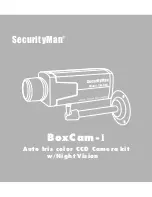
2
DE3630
3. INSTALLATION
Since this is a PowerCode-type transmitter, it is recommended to
power it up and let the target receiver “learn” the transmitter’s ID
before actual installation.
3.1 Battery Insertion
A. Insert the battery into the battery clip - observe polarity (see
Figure 3).
B. Press the tamper switch lever once and release it. This will
perform the reset necessary for smooth power up.
C. Put the cover on and watch the LED. It will flash once in 2
seconds for at least 15 seconds until the sensor stabilizes.
Figure 3. Components Layout
3.2 Registration of the Transmitter ID
in the Target Receiver’s Memory
Refer to the target receiver’s installation instructions and follow the
procedure given there for “teaching” transmitter IDs. It is much
easier to carry out this operation in close proximity to the receiver.
3.3 Selecting the Mounting Location
The MCPIR-3000 can be mounted directly onto the wall (surface
mounted), or in a corner, using the mounting knockouts. Always
mount the unit on a firm and stable surface. Optional swivel
brackets permit greater flexibility when adjusting the coverage
area (Para. 3.8).
A. Select the mounting location so that an intruder's motion will
cross the beams of the selected pattern.
B. Determine the convenient mounting height.
NOTE:
Take into account that installations at increased
heights result in larger blind areas near the detector.
C. To minimize false alarms, avoid aiming the detector at
heaters, sources of bright light, or windows subjected to direct
sunlight.
D. The PIR detector senses the difference between the infrared
energy transmitted by a moving body and the background
temperature. It is therefore recommended that the PIR be
aimed toward the coolest place in the protected area, in order
to obtain the maximum sensitivity in installations where high
background temperatures are expected.
3.4 Direct Mounting
A. Loosen and remove the screw at the bottom of the case (see
Figure 1) and then take the cover off.
B. Punch out the appropriate mounting knockouts in the base.
Note: For wall surface mounting, use the two elongated
knockouts at the middle of the base. For corner mounting, use
two diagonally opposite knockouts at the angled sides of the
base (see Figure 3).
C. Loosen the vertical adjustment screw, slide the printed circuit
board upward and remove it via the “keyhole”.
D. Use the base as a template for marking the drilling points.
E. Drill mounting holes and insert masonry anchors if required.
F. Mount the base in place using two screws.
G. Remount the PC board and secure it with the vertical
adjustment screw.
3.5 Adjusting the Coverage Area
The vertical scale adjustment (printed on the right edge of the p.c.
board) and the plastic pointer on the base indicate (in degrees)
the vertical angle between the upper layer of the coverage
pattern and the horizontal line of the unit.
Table 1. Vertical Adjusting Scale
The scale enables pattern adjustment from +2
°
¡
to -12
°
, according
to the installation height and the required coverage range. To
change the vertical pattern adjustment, loosen the screw to slide
the PC board to the desired angle and tighten the screw firmly.
3.6 Setting the Pulse Counter
MCPIR-3000 detectors are equipped with a programmable pulse
counter which can be set to count 1, 3 or 5 pulses, before
activating the wireless transmitter. Place the pulse count jumper
at the desired setting (1, 3 or 5 - see Figure 4).
Figure 4. Setting the Pulse Counter
3.7 Walk Testing
The MCPIR-3000 is equipped with a LED/WALK TEST jumper
which is set by default to ON. In this default position, the
LED lights for 2 seconds upon transmission by the unit.
To save battery power in normal use, an automatic timer inhibits
the detector for approximately 2 minutes after transmitter
activation. The detector is automatically rearmed 2 minutes after
detection of the last motion.





















